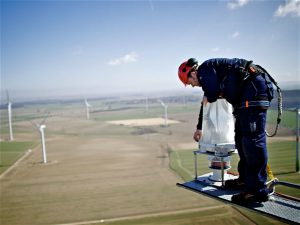The final version of the German environment ministry’s Climate Action Plan has been published. But concrete targets included in previous drafts have been removed, prompting the Green Party to describe the document as an “admission of government failure”. Germany’s powerful industry lobby group BDI meanwhile welcomed the latest version as a “better basis for discussion”.
The Climate Action Plan was announced at the Paris Climate Summit as a framework for how Germany was to reach its goal of cutting greenhouse gas emissions by 80 to 95% by 2050.
Germany is already struggling to meet its 2020 climate targets, and is under additional pressure after Chancellor Angela Merkel repeatedly said she would make climate policy a priority of Germany’s G20 presidency next year.
The environment ministry’s final version of the plan is still to be coordinated with other ministries and will probably be put before cabinet in early November. But critics say it had already been watered down under pressure from Sigmar Gabriel’s Ministry for Economic Affairs and Energy, which insisted on the omission of a date for the coal exit.
In some sections, the environment ministry’s plan now leaves blanks for earlier detailed targets. Environment minister Barabara Hendricks stressed during a press conference that negotiations during the consultation process with the other ministries would still fill these blanks. “We will have to put back numbers and concrete measures, that’s what we’ll work on in the coordination with the other ministries,” she said.
In the initial statement posted on the ministry’s website together with the plan, Hendricks pointed out that Merkel’s Chancellery had asked for further changes to the original draft of the plan.
“I have accepted these amendments to avoid further delays to the necessary discussions within the federal government,” Hendricks said.
But the Green Party and environmental organisations said the Climate Action Plan has lost all power as a blueprint for decarbonising Germany.
“Hendrick’s Climate Action Plan started as a tiger, but turned out to be a toothless tiger-skin rug,” said Green parliamentarians Bärbel Höhn and Oliver Krischer.
Changes to the Climate Action Plan 2050 came after industry associations repeatedly voiced their criticism of sector targets and the listed measures they feared would harm Germany’s economy and competitiveness.
Holger Lösch from the Federation of German Industries (BDI) said in a statement that the latest version provided a better basis for discussions for a reliable and long-term climate policy. The group also reiterated that any national rule had to be in line with European instruments, mainly the EU Emissions Trading System (ETS). Lösch said changes to sections about buildings and mobility would be “reasonable”.
Preamble stresses focus on industry competitiveness
Among other changes, Hendricks made concessions on the transition to renewable transport, one of the weak spots of Germany’s Energiewende.
A June draft said that by 2030 “a large majority of newly registered cars” would have to be powered by electricity or biofuels. But the new plan only states that “the government aims to significantly lower car emissions by 2030” and that e-cars would contribute to that goal.
Greenpeace energy expert Tobias Austrup said the plan’s soft stance on transport put the future of the car industry at risk.
“As long as an emission-free transport sector is not defined as a matter of course, carmakers will continue to dream of a future for the combustion engine – a future that will not exist.”
He added that without a coal exit and specific targets for different business sectors, the plan “lampooned” the spirit of the Paris Climate Conference.
While the environment ministry has repeatedly called for a managed coal exit by 2045 or 2050, other ministries, state premiers in coal mining regions and trade unions have resisted.
Environmental NGOs praised Merkel for pushing G7 leaders to commit to decarbonisation, and for fighting to make the Paris Climate Conference a success.
But the “Climate Chancellor’s” real commitment is under question because of her failure to push for an end to Germany’s dependence on highly polluting brown coal.
Germany increased power production from renewables to over 30% in 2015, yet overall CO2 emissions, as well as emissions from the power and transport sector, have stagnated or increased slightly over the last five years.
Merkel said in her speech during parliament’s debate of the 2017 budget that the Energiewende was one of the long-term projects where the government had “achieved a lot” but still had to keep working on. “This includes, obviously, the climate action plan we are working on,” she said. “But this has to be a climate action plan where we manage to reconcile jobs and the concerns about the climate.”
Policy director of environmental NGO Germanwatch Christoph Bals said “the government appears to lack the necessary courage to agree on a clear strategy” to implement the Paris Climate Agreement, adding that the pending consultation with other ministries was a last chance to create a Climate Action Plan “worthy of its name”.
The cabinet is scheduled to approve the Plan by early November. The Climate Action Plan will not be a law – and so will not be put to a vote in parliament – but rather become part of the government’s energy transition strategy.
Germany’s trimmed-down Climate Action Plan
This CLEW factsheet outlines the main features of the new draft.
“No rigid provisions”
The new version contains more flexible language, and states explicitly that: “It cannot and will not be a detailed masterplan, fixed for decades.” According to its new preamble, the Climate Action Plan 2050 presents measures that will make Germany “largely” greenhouse-gas-emissions neutral “by mid-century”. Yet, there will be “no rigid provisions”. The plan proposes “guiding principles”, serves as an “orientation” for all stakeholders and will “periodically be adapted” (at least every five years).
In contrast to the original draft, the new version does not include emission reduction targets for each sector anymore (energy, transport, industry, buildings, agriculture). Some of the other concrete targets mentioned in previous drafts were either deleted from the current draftor left blank. These were substituted by the note: “xx [value will be set during coordination between the ministries].”
Environment Minister Barbara Hendricks stressed that concrete targets and measures would be introduced after talks with other ministries.
-
Competitive industry
The environment ministry points out that it will place special focus on keeping German industry competitive with “functioning, innovative and complete value chains”. “It is about using the strength and creativity of the German market economy and the forces of competition to attain the existing national, European and international climate targets.”
-
Energy sector
The energy sector, which was previously described as making a “considerable” contribution to the 2030 reduction target of 178-188 million tonnes of CO2 equivalents, is now tasked with contributing “adequately” to the overall reduction target.
According to the draft, the electricity supply will play a significant role for the decarbonisation of all other sectors, for instance through the electrification of transport and heating. Much more electricity than today will be needed. The power sector itself is to be “transformed to an electricity supply based on renewables until about 2050” with emissions “avoided almost entirely” by that time.
To get there, however, natural gas-fired and modern coal-fired power plants have an “important function as interim technology”, says the plan. It does not suggest a timeframe for a coal phase-out, as the original version did.
Instead of saying that coal-fired power production must “end well before 2050” – as the first draft proposed – the document states that “the importance of power production from coal will decrease” and that there will be a “step-by-step reduction” of coal power generation. Setting up a commission on climate protection, growth and structural change is still part of the plan, albeit without the specific assignment to propose a roadmap for a coal phase-out.
In terms of renewables development, the draft proposes additional capacity of 2.5 gigawatts of solar PV every year, but leaves blank the amount of onshore wind power capacity to be installed.
Emissions trading is to be strengthened, combined heat and power and the electricity grid expanded and sector coupling technologies such as power-to-gas further developed.
-
Building sector
The energetic quality of old buildings after renovation may only in exceptional cases exceed the standard for new buildings by more than 40%.
The share of renewable energies in the energy consumption of the building sector is to be increased to 25-30% by 2030, with the aim to reach the higher number. To help reach this target, renewable fuel-powered heating systems are to be “significantly more attractive” than their fossil counterparts by a year yet to be decided. Earlier versions had envisioned a ban of new installation of fossil heating systems from 2030 onward.
-
Industry
For industry, the avoidance of emissions should be “furthered as much as possible”, leaving more leeway than for other sectors. This is in line with the preamble’s focus on a competitive German industry.
Contrary to the first draft, the current plan calls for continued industry exemptions: “Businesses that compete internationally and that within their sector belong to the 10% that are most efficient and have lowest emissions, must continue to receive their emissions certificates free of charge.”
To avoid industry emissions, the environment ministry’s draft puts carbon capture and storage (CCS) back in the mix, despite strong opposition against this technology in Germany.
Setting a European carbon floor price is no longer mentioned.
-
Transport
The original draft stated that the transport sector would have to deliver a “disproportionately high” CO2 reduction in the future because it had not cut emissions at all so far. Yet, the current version says the transport sector has to deliver an “ambitious” contribution. The latest version no longer specifies that the sector cut emissions by 40 percent by 2030 compared to 2005.
For average passenger car greenhouse gas emissions per kilometre driven, the draft leaves blank a concrete target to be decided in the ministry consultations. Before the draft was sent to the Chancellery, a decrease of 45 percent by 2030 was mentioned, compared to 2010 values.
The environment ministry omitted its goal that by 2030 “most newly registered cars will have an electric drive or motors powered by renewable synthetic fuels”, and substituted the sentence: “Until 2030, the federal government aims for a significant decrease of emissions by passenger cars.” A concrete target is slated to be set in 2020.
-
Agriculture
As some emissions in agriculture are unavoidable, the sector is expected to produce roughly half of all greenhouse gas emissions by 2050, which means cutting emissions in half compared to today.
Most emissions in the sector are laughing gas, resulting from the use of nitrogen in fertilisers, so the environment ministry wants to lower the nitrogen surplus in this area. Contrary to the previous draft, no concrete target is named. It will be set in the consultation with the other ministries.
The ministry deleted the notion that the reduction of the ruminant animal populations is “crucial for climate protection” and Germans should hence eat less meat.
Until 2030, 20 percent of all agricultural land should be used for organic farming (2014: 6.3 percent).
-
Land use and forestry
Use forests as carbon sinks; re-naturalise moorlands for the same purpose.
-
Ecological tax reform
The environment ministry suggests that the government come up with a concept for “ecological tax reform”, saying that “environmentally related taxes and levies can cost-efficiently trigger climate-friendly economic behaviour”. Such a reform could include the implementation of “ecologically fair prices” by internalising the environmental costs of harmful products and services. The current draft leaves out the earlier idea to investigate how “additional levies on fossil fuels and heating fuels” could be used to support environmentally beneficiary technologies.
-
Climate friendly investment
The government wants to reduce subsidies that are environmentally harmful.
-
National welfare index
The government should consider a national welfare index – which rates the condition of a nation by the state of its natural resources and ecosystems and damages from greenhouse gases – to be published annually, alongside gross domestic product.
-
Federal bureaucracy
The environment ministry aims for a “greenhouse gas-neutral federal bureaucracy” by 2030.
-
Embed climate protection in local public services
The government should investigate how to make climate protection a higher priority for local and regional level policy, as well as businesses.
This article was originally published here on CLEW and is republished here with permission. Read a CLEW factsheet here.
All texts created by the Clean Energy Wire are available under a “Creative Commons Attribution 4.0 International Licence (CC BY 4.0)”. They can be copied, shared and made publicly







